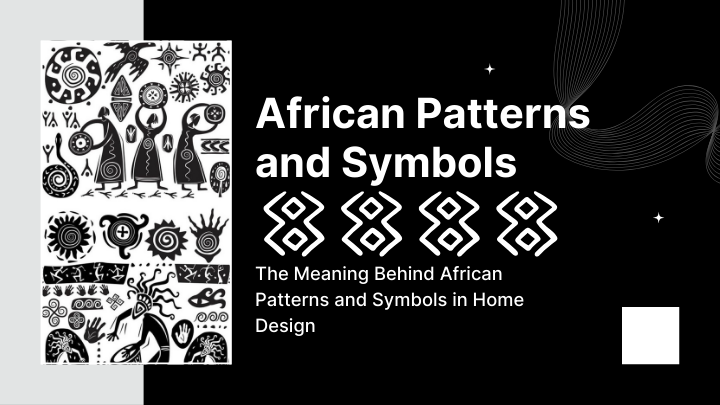African Patterns & Symbols
African patterns and symbols are not just aesthetically beautiful; they are deeply embedded with cultural meanings, stories, and values that span centuries. From intricate geometric shapes to bold, abstract motifs, African design has long been a way to communicate ideas, honor traditions, and celebrate the beauty of life. Incorporating these patterns and symbols into your home decor allows you to connect with the rich cultural history they represent while adding vibrant, meaningful elements to your space.
In this article, we’ll explore some of the most iconic African patterns and symbols, their cultural significance, and how you can bring them into your home design to create a unique, meaningful atmosphere.
1. The Meaning Behind African Patterns
Patterns are central to African design, particularly in textiles, pottery, and architecture. These patterns often represent concepts such as unity, strength, fertility, or protection, and they can vary from region to region. By understanding the symbolism behind these patterns, you can not only decorate your space but also honor the cultural richness they convey.
Geometric Patterns
One of the most recognizable features of African art and design is the use of geometric patterns. Shapes such as triangles, diamonds, squares, and spirals are often used to convey ideas such as balance, harmony, and interconnectedness.
- Triangle: The triangle is a symbol of strength and resilience in many African cultures. It can also represent the relationship between the three key elements of life: birth, life, and death, or earth, water, and fire.
- Diamonds: The diamond shape is often used to represent protection and spiritual connection. It can symbolize the connection between the physical world and the spiritual realm.
- Spirals: Spirals are a symbol of growth and evolution, representing life’s cyclical nature. The inward curve of a spiral suggests transformation and renewal.
Lines and Stripes
Lines and stripes are common motifs in African textiles and crafts, particularly in the weaving traditions of West and Central Africa. These patterns are often used to represent journeys, both physical and spiritual, and can evoke a sense of movement and continuity.
- Vertical Lines: Vertical lines represent endurance, strength, and stability. They are often used in designs that convey the idea of standing tall against adversity.
- Horizontal Lines: Horizontal lines symbolize peace, unity, and balance, creating a sense of grounding and calmness.
- Zigzags: Zigzags represent the unpredictable nature of life. They can be interpreted as symbols of change, challenges, and the journey through life's obstacles.
Floral and Animal Motifs
African art is also known for its depiction of the natural world, including animals, plants, and abstract representations of both. These symbols often carry spiritual meanings, connecting humans with nature and the divine.
- Elephant: The elephant is a symbol of wisdom, strength, and longevity. In many African cultures, it is revered for its ability to overcome challenges and protect its family.
- Birds: Birds symbolize freedom, spirituality, and connection with the heavens. In some African cultures, birds are believed to carry messages from the ancestors or gods.
- Flowers: Floral patterns represent growth, fertility, and the beauty of life. They are often used in textiles and pottery to celebrate the cycle of life and renewal.
2. Popular African Symbols and Their Significance
In addition to geometric patterns and natural motifs, African symbols play a crucial role in home design. These symbols are often used in everyday objects, jewelry, and textiles and hold significant meaning in the cultures they originate from. By incorporating these symbols into your home decor, you can create a space that resonates with deeper meaning and spiritual connection.
Adinkra Symbols (Ghana)
Adinkra symbols, originating from the Akan people of Ghana, are widely used in African design. Each symbol carries a specific meaning, often reflecting wisdom, philosophy, or social values.
- Fawohodie: This symbol represents freedom and emancipation. It signifies the state of liberation from oppression or hardship, and is often used to bring a sense of hope and empowerment.
- Eban: Eban symbolizes safety and security, often depicted as a house or a fence. It is associated with protection and the feeling of being safe and secure within one’s home.
- Duafe: The Duafe symbol represents beauty, cleanliness, and femininity. It is often associated with the nurturing, protective qualities of women.
Bantu Knot Symbol (Southern Africa)
The Bantu Knot symbol is a popular design in many Southern African cultures, representing the connection between generations and the spiritual bond between ancestors and descendants. It is also associated with the idea of continuity and growth, signifying that life is cyclical and constantly evolving.
- How to Incorporate Bantu Knot Symbol: You can bring this symbol into your home through textiles like throw pillows, bed linens, or wall art. It can also be used in hand-carved wooden pieces or as part of a larger design motif in rugs or table runners.
Nkotimse (Unity)
The Nkotimse symbol, often used by the Akan people of Ghana, represents unity and the idea that “together we are stronger.” It is often seen in designs that are meant to evoke feelings of solidarity and community, and it reminds us of the importance of working together for the common good.
- How to Incorporate Nkotimse Symbol: This symbol can be used as a centerpiece in a family room or dining area to inspire harmony and connection. Displaying it on a woven wall hanging or in an abstract design on throw cushions can bring a sense of unity to your space.
3. Incorporating African Patterns and Symbols into Your Home Decor
Now that we’ve explored the meaning behind African patterns and symbols, it’s time to think about how you can incorporate them into your home design. Whether you’re looking to create an authentic African-inspired space or simply want to add cultural depth and meaning to your decor, there are several ways to bring these patterns and symbols to life.
Textiles
Textiles are one of the easiest ways to introduce African patterns and symbols into your home. African fabrics such as Ankara, Kente, and Mudcloth are rich in color and symbolism, making them perfect for creating bold, statement pieces.
- Throw Pillows: Use brightly colored pillows with geometric patterns or symbols like the Adinkra or Bantu Knot to add a touch of African culture to your living room or bedroom.
- Curtains: Hang curtains made from African-inspired fabrics with bold patterns to frame your windows in style. Look for geometric designs, florals, or animal motifs.
- Bedding: Incorporate African textiles into your bedroom with duvet covers or bedspreads featuring vibrant colors and cultural symbols.
Wall Art and Decorations
African symbols and patterns make striking focal points when displayed as wall art. You can find framed prints, paintings, or even woven baskets that feature traditional motifs.
- Framed Art: Choose paintings or prints that showcase African symbols or geometric patterns. These can be hung as part of a gallery wall or used as a single statement piece.
- Woven Baskets: Display woven baskets on the wall to showcase the artistry of African craftsmanship while incorporating cultural symbols. These can be arranged in a circular pattern to create a dramatic focal point.
Furniture and Accessories
African-inspired furniture and accessories can also reflect the rich history of African patterns and symbols. From carved wooden sculptures to clay pots and woven baskets, these items can bring a rustic, authentic feel to your space.
- Carved Furniture: Look for furniture with intricate carvings that reflect African symbolism, such as wooden chairs or tables with geometric designs or motifs like the Adinkra symbols.
- Sculptures and Figurines: Incorporate wooden or metal sculptures that depict animals, people, or abstract forms representing the themes of strength, unity, or fertility.
African patterns and symbols are much more than just beautiful design elements—they carry deep cultural significance and reflect the values, beliefs, and history of African peoples. By incorporating these patterns and symbols into your home decor, you not only add vibrant, meaningful elements to your space but also honor the rich traditions they represent.
From geometric shapes and natural motifs to powerful cultural symbols, there are countless ways to weave African design into your home. Whether through textiles, wall art, or handcrafted accessories, these patterns and symbols will help create a space that feels both personal and connected to the cultural richness of Africa.



